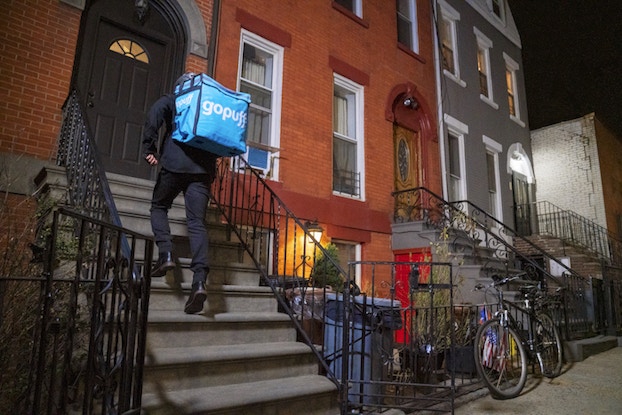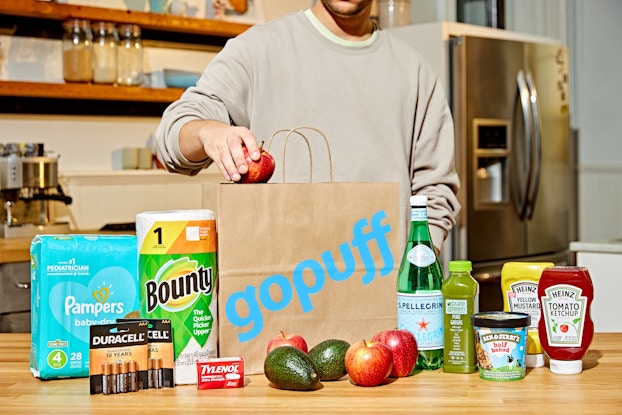
Why it matters:
- Retail media networks, where retailers sell ad space on their digital platforms, are expected to generate $52 billion in revenues this year and $61 billion in 2024, according to eMarketer.
- Indeed, 73% of brands surveyed by the Association of National Advertisers said they expect to be spending more on retail media networks in the future.
- Against that backdrop, rapid delivery service Gopuff offers brands a 30-minute window after customers place delivery orders to target them with additional, post-checkout advertising via its app.
Gopuff, which offers rapid delivery of grocery and other household products in several markets across the U.S. and Europe, is seeking to drive incremental revenues through its retail media network with a new advertising vehicle.
The company has long offered an ad platform for the consumer packaged goods (CPG) companies whose products it sells, but it’s now opened up a new channel for advertisers to reach the delivery app’s customers. Through a partnership with Rokt, Gopuff has begun offering advertising opportunities to non-CPG companies ranging from Apple TV+, Hulu, to lingerie brand AdoreMe and weight-loss platform Noom.
Unlike the CPG companies’ ads, which are displayed as consumers shop on Gopuff, the new ads appear after the customer has placed their order, said Daniel Folkman, Senior Vice President, Business, Gopuff. This ensures that the shopping experience itself is not disrupted by incongruous, or non-endemic, advertising, which promotes a product or service that’s not sold by the retailer.
“Obviously, if you throw an ad for a non-CPG product in the middle of the shopping experience, you’re going to disrupt that experience,” he told CO—.
Swooping in during ‘post-order purgatory’ to pitch consumers products and services
Folkman described that time after customers placed their orders as “post-order purgatory,” when they are waiting at home for their deliveries of groceries or household items to arrive. That 30-minute span, he said, is an ideal window for advertisers such as media companies and others to promote their products and services.
Rokt, which provides a variety of e-commerce services to companies around the world, uses machine learning to present relevant offers to shoppers. It serves up a series of ads from its brand partners to Gopuff’s customers after they check out, based on shoppers’ individual demographics and location.
In addition to Gopuff, Rokt also works with major brands such as Wells Fargo, HelloFresh, Wine.com and others.
Folkman said Gopuff’s predominantly young demographic provides a valuable audience for Rokt’s advertisers.
The data that Gopuff is able to provide for its advertisers about its customers’ click-through rates and other actions offers added value to brands.Daniel Folkman, Senior Vice President, Business, Gopuff
“Customers are able to get access to unique and valuable offers from brands,” said Folkman. “And, it’s accretive to our business because it’s incremental revenue that’s coming post-checkout.”
While Gopuff is known for its rapid delivery of household items and groceries, its business model is much like that of any other retailer. It buys products from wholesalers and distributors and sells them at a markup, unlike some other delivery companies such as Instacart, DoorDash and Uber Eats that shop at various stores and restaurants to fill delivery orders.
Gopuff operates hundreds of delivery locations across the U.S. and Europe, with about 4,000 products at each site.
[Read: Loyalty Programs From Jet Blue, Sweetgreen and Others Evolve to Deliver Experiential Rewards]
The growth of retail media networks and turning rich customer data into sales
Retail media networks, like the one Gopuff has been using to serve up ads to its customers, have become popular among retailers, allowing them to monetize the data they have about their shoppers’ purchasing histories and preferences. Now, Gopuff will be able to leverage its customer insights to provide targeted ads to its customers for a broader range of products and services.
For example, a customer who has just completed an order might see an order confirmation on their screen along with a message that they have “unlocked a partner offer,” such as a free month of Hulu. The customer would have the option to either accept the offer or decline it with a single click.
The proliferation of retail media networks (RMNs) in the past few years is a result of technological advancements, changes in the way consumers shop, and the realization by retailers that they can monetize their customer data via their e-commerce sites, according to a recent report by the Association of National Advertisers (ANA).
The report, “Retail Media Networks: A Forced Marriage or Perfect Partnership?,” cited eMarketer data projecting that ad revenue on RMNs will total $61 billion in 2024, up from an estimated $52 billion in 2023. In a survey of advertisers, the ANA report found that 73% of brands expect to be spending somewhat more or significantly more on RMNs in the future than they spend today.
[Read: Supermarkets and Startups Offer Big Lessons on Driverless Product Delivery]

Encouraging results: Ads achieve what Gopuff calls a ‘higher-than-average engagement rate’
In the first weeks of offering the new ad platform, Gopuff’s results have been encouraging, Folkman said. The ads have achieved what Gopuff described as a “higher-than-average engagement rate” of 5%.
For its CPG advertisers, Gopuff has sought to create multi-faceted advertising opportunities. For example, brands can combine various forms of digital messaging online and in the Gopuff app with “in-bag” elements such as inserts and product samples that are delivered to customers’ homes with their orders. Some of these in-bag promotions have already involved non-CPG companies such as Netflix, Hulu, and Pluto TV, which have distributed materials to promote their content, but Folkman said the company sees the opportunity to grow this revenue stream.
Pluto TV, for example, promoted its streaming service last year by including free bags of popcorn in Gopuff deliveries alongside an insert highlighting Pluto TV’s free slate of summer movies. Gopuff has also recently focused on its in-bag product sampling opportunities, such as one campaign it conducted with Tums brand in which it included free samples of Tums along with a QR code that enabled customers to easily reorder the product.
“What we’re looking at now is, how do we pair all of that stuff together?” said Folkman. “With CPG advertisers, we’ve really done a nice job creating multiple touch points for brands to engage with our consumer.”
In addition, the data that Gopuff is able to provide for its advertisers about its customers’ click-through rates and other actions offers added value to brands, he said.
“We're looking at replicating that in a way that’s relevant for the non-CPG brands, because we think that the data behind our business is really what powers everything,” said Folkman. “That level of sophistication that we've been able to develop and then report out on is really where the value lies.”
CO— aims to bring you inspiration from leading respected experts. However, before making any business decision, you should consult a professional who can advise you based on your individual situation.
CO—is committed to helping you start, run and grow your small business. Learn more about the benefits of small business membership in the U.S. Chamber of Commerce, here.

Interested in a small business membership?
Find out how the U.S. Chamber of Commerce can help your company grow and thrive in today's rapidly-evolving business environment. Connect with our team to learn how a small business membership can benefit your bottom line and help you achieve your goals.







